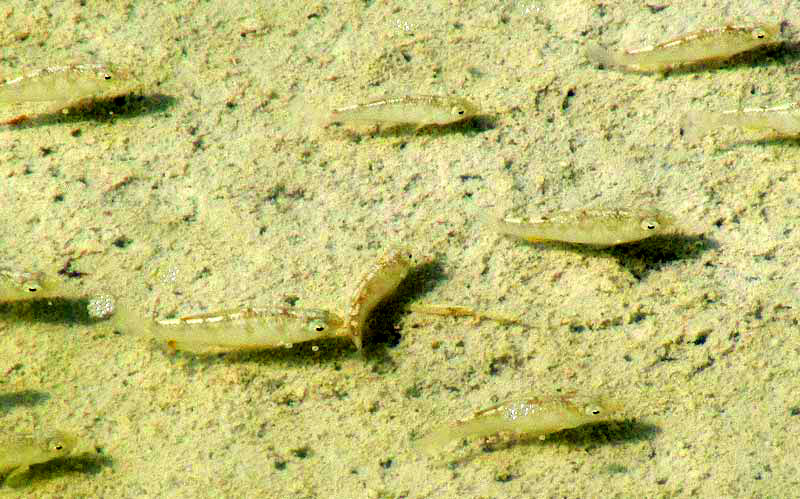Excerpts from Jim Conrad's
Naturalist Newsletter

from the May 31, 2015 Newsletter issued from Río Lagartos, on the Yucatan Peninsula's northern coast (~N21.60°, ~W88.16°), Yucatán state, MÉXICO
YUCATAN PUPFISH
Sometimes after looking at flamingos we pull up to the edge of levies enclosing the salt ponds at Las Coloradas, so visitors can see the operation. At the base of one levy, on the estuary side, there was a car-size pool of water less than finger-length deep inside which schools of small, silvery fish were swimming back and forth. The fish were no more than an inch long (25mm). You can see them above.
What interested me was that the fish were swimming in exceedingly salty water. Sea water's salinity is rated at about 35.5 PSU (Practical Salinity Units), with water of the famously salty Dead Sea being around 40 PSU. A 2004 study by Valdes and Real, published in the Indian Journal of Marine Sciences, found that during the dry season, when salinity in Ría Largartos Estuary is at its maximum, salinity averages over 69 PSU. In some parts of the Estuary's inner zone it can soar to over147 PSU. That's over three and half times saltier than sea water. And these fish -- here at the dry season's absolute peak when the estuary's water should be the saltiest and right beside the salt ponds famed for their salty water -- appeared to be doing quite well.
But, what where they?
In a 2010 study of fish in Ría Lagartos Estuary, Peralta-Meixueiro and others found that of the 63 fish species they identified in the estuary, two species predominated in the estuary's most saline waters: Cyprinodon artifrons and Floridichthys polyommus.
The fish in our photograph were only about an inch long (25mm) and their color pattern was not yet well developed. However, seven or eight dark, vertical bands can be discerned along their sides, their eyes can be seen surrounded by pale zones, and the fishes' head shape can be made out. These features all correspond to those of young CYPRINODON ARTIFRONS, one of the estuary's two most salt-tolerant fish. With age the banding in this species becomes much more conspicuous and the fish's body shape changes. Cyprinodon artifrons often is known as the Yucatan Pupfish.
Studies indicate that Yucatan Pupfish don't necessarily prefer very salty water -- the species tolerates a wide range of water, including freshwater -- but rather the young seek out very salty water probably because most other fish species can't tolerate it. Thus in very salty water Yucatan Pupfish young find less competition for food from other species, and there's less threat of predation by larger fish of other species.
Not only are Yucatan Pupfish found in Ría Lagartos Estuary's very salty waters, but also it's one of the most numerically abundant species throughout the estuary, even in the least salty zone near the estuary's mouth.
Mature Yucatan Pupfish average about 1½ inches (4cm). The species seems to be endemic just to waters of the Yucatan Peninsula and Belize.